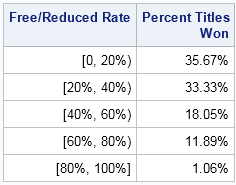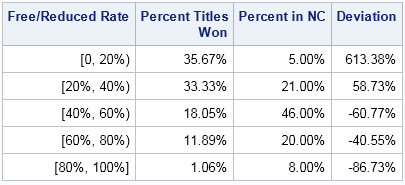The Raleigh News & Observer published a front-page article about the effect of wealth and poverty on high school athletics in North Carolina. In particular, the article concluded that "high schools with a high percentage of poor students rarely win titles in the so-called country club sports—tennis, golf and swimming—and the number of sports in which the more affluent dominate is growing."
The article analyzed state championships from 2001 through spring 2013 and concluded that "the percentage of students receiving free or reduced-price meals, which is an indication of students living in need, is a predictor of high school athletic success." The authors presented data on the number of state titles won in 10 sports, including baseball, men's basketball, football, volleyball, and the "country-club sports" for men and women. In percentage terms, the published results were as follows:

According to these statistics, almost 36% of state titles over 13 years were won by relatively affluent schools: those for which less than 20% of the students are eligible for free or reduced meals. Another 33% of titles were won by moderately affluent schools that had between 20% and 40% of "needy" students. In contrast only 1% of titles were won by high schools for which 80% or more of the students are needy.
Upon first glance, these numbers seem to back up the author's claims. But do they? The story leaves out an important fact: what is the percentage of NC high schools in each of those five categories? After all, if 36% percent of the NC schools are affluent and only 1% are impoverished, these numbers merely reflect the distribution of schools within the state.
The NC Department of Public Education provides data for the 2013-2014 school year on free and reduced meals at all NC public schools. I restricted the list to high schools and used SAS software to tabulate the percentage of public schools in each category. You can download the CSV file with the school-level data and the SAS program that I used to analyze the data. The following table summarizes the results.

In 2013, only 5% of public high schools in NC were "affluent," as determined by having 20% or fewer students qualify for free or reduced meals. In contrast, 8% of NC high schools had 80% or more of the students qualify.
The data indicate that the advantage of wealth (and disadvantage due to poverty) is even more pronounced than the article indicates. The affluent schools won 613% more state titles than might be predicted based on their relative numbers. The schools with the highest percentage of poor students won 87% fewer titles than their relative numbers would indicate.
In short, affluent schools win many more state titles in NC than their relative numbers might suggest, and the percentage of students receiving free or reduced-price meals is a highly significant factor in predicting state athletic titles in the 10 sports listed by the N&O.
Of course, the situation is more complex than merely counting the number of schools in each category. Larger schools have more students to draw from. Suburban schools might be located closer to training facilities that offer off-season clubs and clinics. The more affluent schools might be able to recruit and retain better coaches.
With more data and more statistics, you could build better statistical models, but I think the results are clear. For NC high school athletics, wealth and winning are highly correlated.

2 Comments
Rick, from having attended many swim meets at Triangle Aquatics Center in Cary watching my sons compete representing Enloe and Cardinal Gibbons, I think an important and influencial reason why these schools and those like them have greater success than other schools in swimming, and most probably the same for tennis and golfing, is that their kids have parents willing and able to afford lessions away from school, and/or dedicate an hour to hour and a half, two to four times a week for training, at somewhere nice and fairly near to where they live, and have parents willing to run them to and from training, and be involved in these/their sport.
Nothing to do with schools, and whether there are considered affuent or not.
Correlation does not imply causation. Plain and simple, I think it's attraction to particular popular sports among demographics and facility availability in the area.
Trevor has a good point as well in the comment above.